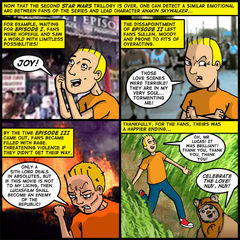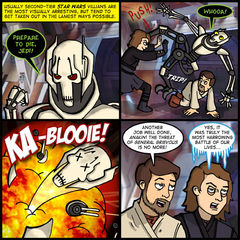Is it weird that I had to employ the internet to uncover the lyrics to the Ewok celebration song from Return of the Jedi? I wasn’t sure if it was “Nub, nub!” or “Nuv, nuv!”
I suppose if it was “Nub, nub” the phrase “celebrate the love” would take on an entirely different meaning!
Family comic! Family comic! Bad artist! Bad!
We didn’t get a chance to see Star Wars: Episode III – Revenge of the Sith over the weekend. Part of it was due to a busy schedule, but part of it was just good sense to stay away. We knew the theaters would be packed, and since I saw the movie on Wednesday, there was no need to torture ourselves. We’ll probably see it tonight when there will be less people in the theaters.
Anyway, instead of combating the nerd hordes, Cami and I instituted a little counter-programming this weekend and saw Enron: The Smartest Guys in the Room. It’s a documentary adapted from the book by Bethany McLean and Peter Elkind.
What can I say about the film? It’s not a real heart-warmer, obviously. I guess while watching it, I kept thinking of that old saying “If you’re not outraged, you’re not paying attention.” There’s plenty that Ken Lay, Jeff Skilling and Andrew Fastow perpetrated to be outraged over.
I won’t go into the details because I know reading about white collar corporate greed is just about as exciting as writing about it, but for your own edification, you should see this movie.
Co-author Bethany McLean hits the nail on the head very early in the film when she comments (and I’m paraphrasing) that the Enron scandal seems to have become this obtuse construct in the minds of the average American. Most people think that the scandal revolves around complicated transaction and the pocketing of hidden assets. That the money trail is too complicated to follow and therefore not worth attempting to understand.
In reality, the story of Enron is more about people. The hubris over the over-competitive and a compulsory need to prove superiority above authority. Their theories as to the personal motivations of Skilling in particular could be a wonderful psychological case study.
The movie touches lightly on a Republican conspiracy to oust California’s Democratic Governor Gray Davis by tracing the responsibilities of the rolling blackouts his state suffered back to Enron. This isn’t the focus of the film by any means. Ultimately, Enron was responsible for the blackouts, but money was their prime motivation. Still, it’s hard to deny their association to the Bush administration considering Enron was the largest corporate backer of that campaign.
But I’m getting off track. I don’t mean to politicize things and I don’t want to give the wrong impression. Ultimately, the movie takes what most perceive to be a very complicated issue and walks you through it step-by-step. After watching it, the puzzle pieces fit together much more easily and for that, I think it’s worth your movie going dollar.
Part of me feels that making a comic that criticizes George Lucas’ choices in the Star Wars prequels is kind of like sitting in a rocking chair – it gives you something to do, but you don’t go anywhere.
However, the idea of Anakin pushing General Grievous over the back of Obi Wan, leading to a dramatic explosion, was too funny to me. As you can see, I tried to play up the cartoon outlandishness to the hilt.
In the vein of characters muttering “I have a bad feeling about this.” and lightsaber adversaries losing limbs left, right and center – quickly and unoriginally disposing of cool-looking secondary vilians has becomes something of a Star Wars tradition.
It’s frustrating to a degree because Lucas’ art direction team has it in them to invent some incredible baddies. They build them up so that we think they are the most heinous, devious, impervious challenges our heroes will ever face. Then they are quickly disposed of in undignified ways. It seems like such wasted potential.
Naturally, the first victim to this folly was Boba Fett way back in Star Wars: Episode VI – Return of the Jedi. Absent-mindedly knocked into the Pit of Sarlacc, he was left to digest for 1,000 years. The biggest, baddest bounty hunter in the galaxy – SO TOUGH HE DOESN’T EVEN HAVE TO TALK! – dies in a way so undignified, Lucas might as well had him slip on a banana peel and split his head open on a rock.
Now we can kind of let this one slide, because at the time the original trilogy came out, he didn’t realize that Boba would capture people’s imagination so thoroughly. He envisioned him as this kind of background character. Totally disposable. Okay, fine. We’re not weeping into our Cheerio’s for that random Gamorrean guard who is fed to the Rancor.
However, this doesn’t absolve him from the absolute disregard for the great villians created for the prequels – Darth Maul, Jango Fett and General Grievous. Each one of these creations is billed as a major threat, but are removed from the equation in the lamest ways possible.
Darth Maul? The first Sith seen in 1,000 years. Proves his bad-assery by ventilating Qui Gon Jinn, but plucky young padawan Obi Wan Kenobi takes a lucky swipe and separates his legs from his torso. Enjoy your ride into obscurity down that random, bottomless shaft!
Jango Fett? First off, he’s a Mandalorian. Their reputation proceeds them. Second, he’s chosen as the template for the Clone Army. There must be something special about him, right? Wrong!
He barely gets out alive after a clumsy tussle with Obi Wan on Kamino and gets his head sliced off by Mace Windu without the erstwhile Jules Winnfield breaking his stride. Perhaps this is why the Stormtroopers are such a terrible shot?
Finally, General Grievous. The metaphorical alpha version of Darth Vader. An alien who swapped out most of his organic parts for mechanical substitutes. This guy kills Jedi FOR FUN and takes their lightsabres as keepsakes.
When he was introduced in the Star Wars: Clone Wars mini-series on Cartoon Network, he was a grisly, swift spectre of death, able to take out four Jedi all by his lonesome.
Too bad he didn’t employ the foresight to forge a more durable carapace. One that wouldn’t crack like a lobster shell when Obi Wan crams his hands into the opening between his chest plates, exposing his weakened heart and lungs to “uncivilized” blaster fire.
What recourse do these indelible characters have when their creator tosses them aside so readily? I mean, it makes sense to a degree because you want to introduce as many new, exciting visuals for each movie. If Darth Maul had been running rampant through all three prequels, it might have become stale. And certainly there would be less merchandising opportunities!
Lucky for us there is the Expanded Universe. The comic books and novels where writers who understand what it means to cherish an original character will flesh out their back stories and give them the respect they deserve.
Except R.A. Salvatore. I still haven’t forgiven him for killing off Chewbacca in Vector Prime…







